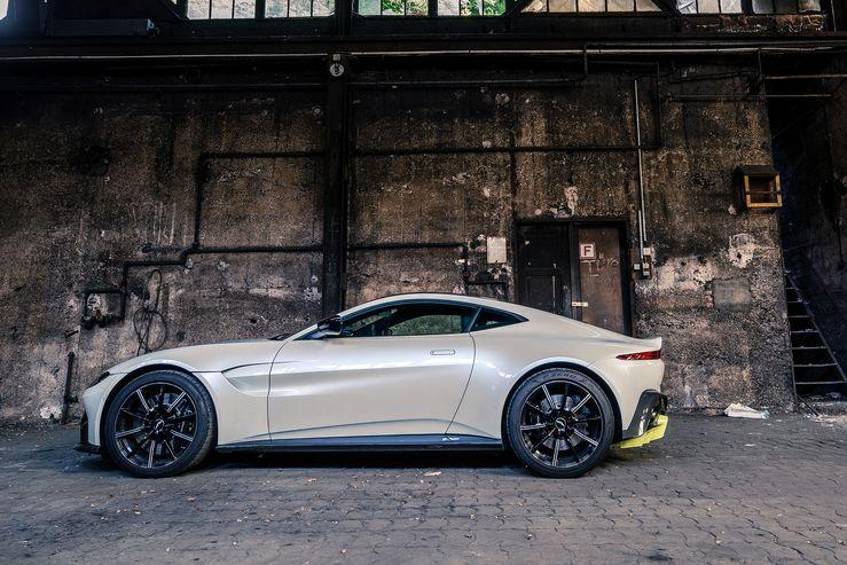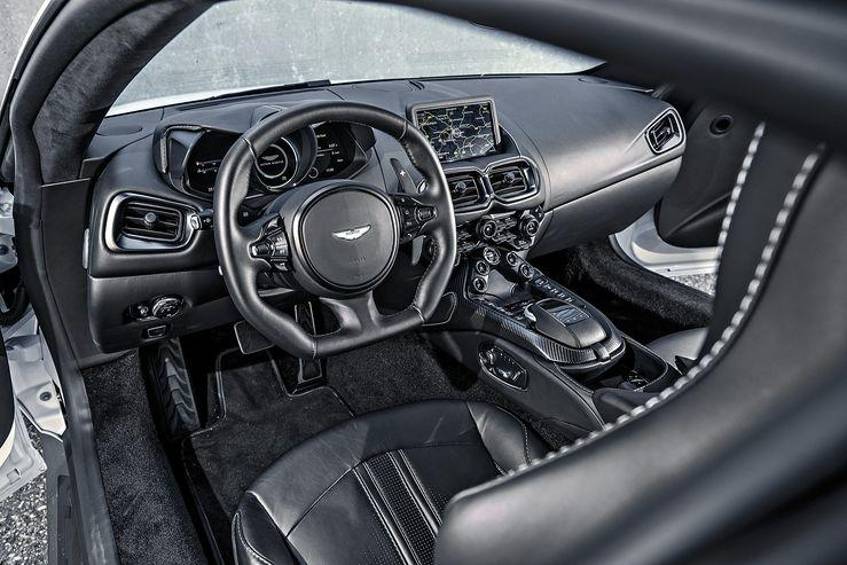“Please start your engine”, we do of course in the new Aston Martin Vantage V8 very much. The sports car with rear-wheel drive and turbo power makes chase on Mercedes-AMG GT S and Porsche 911 Carrera GTS.
In the Aston Martin Vantage V8 comes the engine of Mercedes-AMG – the four-liter V8 biturbo from the GT with 510 hp and 685 Nm of torque . Also, virtually everything is new to the small series.
Prototype and predecessor
Four-liter V8 biturbo
Conclusion
Let’s straighten up the Aston Martin Vantage from the back because that’s where the most important thing comes in the end. So back – where driving meets on the road. Although the engine sits under the front hood, the power center of the Aston is clearly behind. The linchpin, the core of fast locomotion.
Fast locomotion. It is not the tempo sting. Not even the charm to handle a section in minimal time or a curve with maximum lateral acceleration. No, the Vantage lacks the speed of driving. This has something relaxing.
500 and more horsepower can certainly create tension. When they incite the driver, prompt him to give up, more and more – only to show him off or even to humiliate him. The latter can happen when the machine ignites enthusiasm in humans, but does not build a direct line, which survives even extreme situations absolutely tear-resistant.
Vantage and driver connect this wire; It stretches on the shortest possible way from the rear wheels to the low-lying and far back-shifted sports seat. One squats, so to speak, directly on the point of detection – the place in which the forces flow together.
There are models that communicate mainly on the front axle, so the steering. Aston’s new two-seater is also eloquent at this point, but only its rear axle gives the information a three-dimensional depth, argues so emphatically, as the predecessor Vantage never could. He was more of a car to linger. Now the new man drives with a fluid self-evident, which lies between everything superimposed drudgery and meaningless lightness.
The time was overripe
Little could take over from the predecessor, because over twelve long years they have been working on the small series. The time was over for something else. And the very other comes from the big brother, the two-plus-two-seater GT .

Even if little externally suggests: Vantage and DB11 share the chassis structure of aluminum , with only one-third should be identical. The rest was heavily cut and also a little relieved – to 83 kilograms. Hard is the new yet, brings fully fueled 1.720 kilograms on the scales. For comparison: A Mercedes-AMG GT S comes to 1,629 kilograms.
Another German sports car icon served as an archetype for English designers: the 911. Of course not for the drive layout, because in the rear is not the engine, but only the automatic transmission. Rather, the Porsche was the blueprint for ergonomics. You sit down and feel well cared for.
What reads so succinctly describes the source code of a sports car. Because more than the engine power counts the feeling of belonging from the first moment. This is the case at the Vantage , even if the low seating position and the narrow window surfaces add up to a remarkably poor clarity. Naturally, this bothers a lot, especially in the city and mates unfavorably here with the enormous body width.
On the road, however, the two-seater hugs closer to his driver, enclosing him without narrowing. This is partly due to the perfect alignment of the driver with the steering wheel and the pedals. The engineers have resisted the attempt to interpret the steering ratio too directly, which seems to be in vogue at the moment, to make overhanging bodies subjectively smaller – and unfortunately often ends in steering ADHD.

The Vantage goes from any form of Hibbeligkeit, he does not react overactive to least impulses. This is also pleasant insofar as he can reach over an unpaved highway about 300, runs straight ahead without stubborn and leaves no sweaty hands. At least when the runway is flat. When bumps, however, un-calmness comes into the chassis, because they are not neatly rebounded.
The setting is more like the country road. There the Vantage reacts to a clean steering with an equally clean stroke. Without correction. Also in the driving dynamics tests, he is a pleasant partner – the rear axle laces track stable through the pylons course, the E-Diff distributes the torque routinely, the maximum speed is reached almost immediately, without having to approach the border area.
On the other hand, it is clear that the new does not blow to the attack, not let hang out the entertainer. How he casually presents his performance potential casually: What initially seems to be a loose -knit swinging rope is in fact carving at high speed, supported by the inexhaustible torque of AMG’s eight-cylinder biturbo.

Hardly a better propulsion partner can be imagined for the Aston Martin , especially since Mercedes also supplies the digital infotainment in addition to the engine side. The Comand system does not correspond to the latest state of the art, but even this actually outdated version beats the device built in its predecessor in all respects.
The casualness of the V8
In contrast, corresponds to the four-liter V8 to minimal changes to the state, how it incorporates AMG in the GT S, makes 510 hp and forces the propeller shaft to ZF eight-speed automatic transmission on the rear axle up to 685 Nm. In a nutshell, he can do better than the former 4.7-liter V8 naturally aspirated Aston Martin .
Above all, the efficient nonchalance of the eight-cylinder impressed. He advances the Vantage almighty, requires only medium speeds. Of course, the engine also has speed bite – but you rarely have to snap it shut. Thus, the basic equanimity of the Aston results in a fuel consumption of 12.3 liters per 100 kilometers – acceptable against the background that it requires plenty of energy to move massively forward mass.

To keep the engine from sounding too Teutonic, Aston technicians have dampened the AMG-typical displacement basses and raised the aggressive upper sports engine centers. Although this has little in common with the previous Aston sound, under load the V8 sounds not only extremely potent but downright evil.
It may be that some customers in the long run even too many decibels hit the ears, especially on longer distances. And that some will miss a suspension mode called comfort right there – the gentlest setting is not unduly sport. And because the taut Vantage on bad slopes passes much of the tectonic restlessness, that stimulates some parts in the dashboard for quiet chirping.
But while there is room for improvement, the new Vantage is superior to its predecessor in virtually all respects. And the hero status in the sports car world much closer.
Technical specifications:
Vantage 4.0 V8
Power: 375 KW (510 HP)
Torque (at rpm): 685
maximum speed: 314 km / h
Base price: € 154,000

